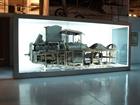Wings of Jutland tell unknown story of aircraft in the clash of battleships
These are the battered remains of the only aircraft to take part in the greatest naval battle ever fought in European waters.
On the afternoon of May 31 1916, this Short 184 seaplane made history - the first aircraft ever to spot an enemy fleet in battle at Jutland.
As part of the Navy’s 100th anniversary commemorations of the clash between the British and German Navies, the fuselage will take centre stage in a new exhibition on naval aviation in the Great War at the Fleet Air Arm Museum in Yeovilton.
Launched from HMS Engadine, the seaplane flew a 50-minute mission scouting ahead of Admiral Beatty’s battle-cruisers.
The Short reconnaissance role was a real menace to the German shipping.
Dave Morris
Pilot Frederick Rutland took the Short - top speed just 88mph - to within one and a half miles of the German Fleet at an altitude of just 1,000ft, while his observer George Trewin radioed the number of enemy ships sighted and their location - all the while under fire as the biplane flew through clouds of shrapnel; the exploding shells missed the aircraft by just 200ft.
Trewin’s messages got through and within half an hour, battle-cruisers on both sides were exchanging shells - the beginning of a battle which saw more than 8,500 men killed and 25 ships sunk.
Rutland was awarded the DSC for his skilful flying, was labelled ‘Rutland of Jutland’ by the press, and was singled out in Beatty’s dispatch on the battle.
His story and that of his aircraft at Jutland - there will be a display to give an idea of what it looked like in its heyday - are the centrepiece of the exhibition which opens on May 18.
Also going on display will be a replica Sopwith Baby, ‘armed’ with Le Prieur anti-Zeppelin rockets (the then Royal Naval Air Service was responsible for the air defence of Great Britain during the Great War), forerunners of air-to-air missiles, although really just glorified fireworks.
“The Short reconnaissance role was a real menace to the German shipping.
"It was one of the first aircraft to be built in Yeovil by Westland Aircraft Ltd, so it’s really significant to have it here at the museum,” explained Dave Morris, aircraft curator at the FAA Museum..
“Poor weather at Jutland actually kept the Zeppelins out of the game and this allowed the Short 184 to spot German battleships and relay vital messages back to the British Fleet.
The exhibition will also bring to life Short 184’s famous pilot Frederick Rutland - he went from being a hero in World War 1 to being interned as a traitor in World War 2.
“We’re equally excited about the impressive Sopwith Baby replica. The two aircraft and their stories will look stunning and I’m sure will excite many visitors, old and new.”

